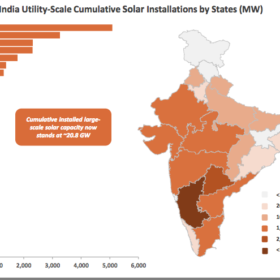Gujarat Borosil to invest INR 4.35 billion in solar glass
With this investment, the company plans to more than double its manufacturing capacity of tempered solar glass from 180 tonnes per day to 400 tonnes by 2020. Currently, it meets 30% of India’s demand for solar glass. With the expansion, it aims to become the market leader by catering to about 60-70%.
Is SoftBank’s $100 billion investment in Indian solar realistic?
While news of Japan’s SoftBank announcing up to USD 60-100 billion investment in India’s solar PV power generation is creating ripples across the industry circles, industry analysts feel that the committment sounds unrealistic in view of India’s current PV market status and future needs.
India saw more utility-scale PV tenders in Q1 2018 than in entire 2017 – Bridge To India
India saw the issuance of 13 new utility-scale solar PV tenders totaling 11,945 MW in the quarter ending March 31, 2018, which is 68% more than in the entire of 2017. However, tender capacity for rooftop solar PV (greater than 1 MW in size) was down 50%, at 102 MW.
2018 global PV market to see negative growth following China backtrack
Global solar PV demand this year will be less than in 2017, on the back of China’s latest policy decision, says TrendForce. Overall, it sees new installs dropping 40% in China to 31.6 GW. The protectionist measures taken by the U.S. will also be weakened by the resulting falling module prices.
BHEL wins INR 1.25 billion worth of solar PV plant orders in Gujarat
The first order for installing a 20 MW PV power plant has been placed by Gujarat Alkalies and Chemicals Limited (GACL), while the other, for a 10 MW PV power plant, has been received from the Gujarat State Fertilizers and Chemicals Limited (GSFC). Both of the solar PV power plants will be installed at the Gujarat Solar Park in Charanka, Gujarat.
India records best ever quarter, but safeguard duties holding solar industry back – Mercom
According to Mercom India, the Indian solar PV industry has recorded its strongest quarter since the launch of the National Solar Mission. In addition to declining module prices, both rooftop and utility-scale installations saw strong growth. Clarity is needed, however, on the ongoing safeguard duty saga, to drive the industry forward.
India to launch its own battery cell production
India’s PV sector is expanding at a serious pace, creating jobs and further securing energy supply for many businesses. Yet, sourcing battery cell technology at the current rate resulted in annual foreign exchange of Rs. 1012 crore creating deficits, that hopefully can be averted in the future.
Fortum selling 54% shares of its 185 MW PV portfolio in India
The company was adamant that it will not exit the Indian PV market, after rumors last October suggested that the company will sell its PV assets in India. Now, the company reiterates its commitment and stresses that additional funding will be used to develop new assets.
Cabinet approves Phase III of off-grid and decentralized solar PV applications programme
Continuation of the programme will help India to achieve additional 118 MWp off-grid solar PV capacity by 2020. The total project (including solar street lights, standalone solar PV plants and solar study lamps) will cost Rs 18.95 billion, of which Rs 6.37 billion will be provided as central financial assistance
Azure Power secures 25-year PPA for 75MW project in Assam
Earlier this year the state announced it would install an additional 590 MW of solar PV to meet growing energy demand. Last year Assam had a 4.2% energy deficit.












